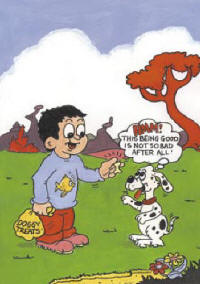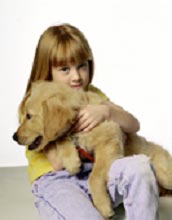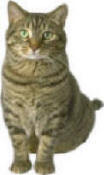The
best way to train your pet is
through the proper use of positive
reinforcement and rewards while
avoiding punishment. The goal
of training is for the pet to "learn"
the proper task and/or behavior.
The training sequence is to
give a command (verbal cue), to get the desired
response and to use a reward
to mark and reinforce the correct
response.
Generally the most
difficult aspect of training
is to find techniques that immediately
get the desired response after
each command. Using food lures
is one such technique.
How
does learning take place?
Learning
occurs by establishing the relationship
between behavior and consequences.
There can be different possible
outcomes of behavior. The relationship
between behavior and consequences
can be positive or negative.
When
there is a positive relationship
between behavior and consequences,
the more your pet performs a
certain behavior, the more of
the consequence he/she receives.
If there is a negative relationship
between behavior and outcome,
the more of the behavior the
pet does the less of the consequence
it receives. When we increase
a behavior by removing a stimulus
this is known as negative reinforcement.
For example, when a dog barks
at an intruder (such as the
postman) the barking has been
reinforced because the stimulus
(the postman) was removed. Negative
reinforcement can also be used
for training when a pull on
a head halter or a spray of
citronella is terminated as
soon as the desirable behavior
is observed.
What
is positive reinforcement?
Positive
reinforcement is anything that
increases the likelihood that
a behavior will be repeated.
There is a positive relationship
between behavior and consequence.
The more the pet does a behavior,
the more consequence he or she gets
and what he/she gets is good. This
makes that behavior increase.
What
kinds of things will a dog consider
positive reinforcement?
They
will differ from dog to dog.
For some it may be
enthusiastic praise, a pat on
the head, a play session, a
fun toy, a walk, or a food treat.
The key is to select the reward
that motivates your pet. It
can be useful to feed your dog,
depending on its age, at one
or two scheduled meal times.
Training sessions can then be
performed just prior to mealtime
when the dog is at its hungriest.
Most puppies can then be motivated
with pieces of food.
In the
same way, toys, play sessions
and affection can be withheld
until training time so that
the dog is "hungrier"
for these rewards. Some of the
dogs that are hardest to train
are those that are difficult
to motivate. These dogs may
do better with a few special
treats that are saved specifically
for training sessions (e.g.
hot dog slices, small morsels
of cheese), or pieces of dog
food sprinkled with flavoring
such as powdered cheese or garlic.
By the way, if there's
no good reason to give your
dog a treat, don't - it
fills him or her up, and accomplishes
nothing. Consider these tidbits
and biscuits not as treats but
as "training rewards".
If these rewards are saved exclusively
for training they become more
motivating and the pet will
learn quickly what behavior
leads to that reward.
Whenever
you are giving the dog something
of value from food to a walk,
first give your dog a command
so that each reward can be earned.
How
do I properly use positive reinforcement?
The
proper use of positive reinforcement
is more than just giving a treat
or a pat on the head. The timing
of the reinforcement is very
important. Remember, your pet
is behaving all the time. So,
you need to be sure to reinforce
the behavior that you want and
not some other. Therefore, closely
associate the reinforcement
with the behavior you wish to
increase. Reinforcement must
immediately follow the behavior.
If there is any delay, you run
the risk of the pet engaging
in another behavior while you
are administering the reinforcement.
One example is when you teach
a dog to sit. You tell your
dog to ‘sit', and
lure her into the position.
While you are saying ‘good
dog' and giving a food
treat, the dog stands up. What
has just happened? You have
rewarded ‘sit' and
‘stand up'.  Another
example is when you are house-training
your dog. You send your dog
outdoors to eliminate and as
soon as the dog is finished,
you call the dog back into the
house, dry her feet and give
it a reward. What happened this
time? You just rewarded your
dog for coming back into the
house and having the feet dried. Another
example is when you are house-training
your dog. You send your dog
outdoors to eliminate and as
soon as the dog is finished,
you call the dog back into the
house, dry her feet and give
it a reward. What happened this
time? You just rewarded your
dog for coming back into the
house and having the feet dried.
Should
I reward my pet every time?
The
frequency of reinforcement is
important. The rate at which
behavior is reinforced is called
the "schedule".
There are several different
schedules of reinforcement.
A.
Continuous reinforcement.
Every time your pet engages
in a behavior it is reinforced
with a reward. While this may
sound like a good idea, it is
actually less than ideal. Once
the pet has learned a new
response, if
you reward a behavior continuously,
once you cease rewarding the
behavior, it will often stop.
B.
Ratio or variable rate of
reinforcement. The reinforcement
does not come after each performance
of the behavior but intermittently.
This may mean that instead of
a reward every time, the pet
gets a reward every third time,
then perhaps two in a row, then
maybe not until the pet has
performed the behavior five
more times. What happens if
you reward this way? Behavior
tends to be stronger and last
longer. Always praise positive
behaviors.
C.
Start training new commands
or tasks with continuous reinforcement
but switch to intermittent,
variable rates as soon as your
pet is responding consistently.
What
if my rewards are not working?
First,
you may not be reinforcing the
correct task. Remember the example
of ‘sit' and ‘stand
up'. Be sure that the
timing of your reinforcement
is immediately after the behavior
you wish to increase. Second,
you may be phasing out your
reinforcement before your pet
has adequately learned the new
behavior. Go back to basics
and be sure your pet understands
what to do in a variety of
locations and circumstances. Therefore, until
your dog consistently responds
to the command, it can be valuable
to leave a leash attached so
that you can immediately show
your pet what it is "supposed"
to do. It is also possible that
you may be repeating commands
several times, or in different
ways and thus confusing your
pet. Ask for our handouts on
training for specific tasks
for additional help.
What
type of rewards should I use?
Rewards
do not always have to be food.
For many pets, just owner eye
contact and attention
can be a reward as can a walk
in the park or a game of fetch.
What is important is that you
see the reward motivating
your pet. Remember, you
need not give a "special"
reward such as food each time
your pet performs a task, but
always acknowledge good behavior
if only with praise or affection.
Is
there a wrong way to reward
my dog?
Yes.
We may reinforce behaviors that
we do not want. Remember that
positive reinforcement makes
behavior increase. So, there
may be times when you may be
inadvertently giving reinforcement
when the pet is exhibiting a
behavior that is undesirable.
Giving any form of attention
to a barking dog, a dog that
is jumping up, or a dog scratching
at the back door only serves
to reward the behavior. Sometimes
people even give a bit of food,
pat the dog, or play with it
in an attempt to calm it down.
What they are really doing however
is reinforcing the problem behavior.
Similarly you may think that
you are punishing your dog when
you are indeed reinforcing behaviors.
Examples include scolding your
dog with an insufficiently harsh
tone of voice, or gently pushing
the dog away when it is play
biting. What is worse is that
when these behaviors are rewarded
occasionally or intermittently,
the behavior becomes stronger
and lasts longer (see above).
A reward should never be given
unless it is earned.
What
are other ways in which rewards
can be used?
There
are other situations where rewards
can be most helpful. For example,
it may help a puppy or even
an adult dog to learn to accept
new people if that greeting
is always coupled with a food
treat. This will help the pet
learn that new people bring
something good. In other cases,
rewards can be used to encourage
desirable behavior. Food enhanced
toys may encourage a dog to
chew on them instead of the
household possessions. (Ask
for our handout on ‘Destructiveness
– Chewing' for examples).
Removal of a reward as soon
as the dog exhibits undesirable
behavior is another training
tool known as negative punishment
(e.g. stopping play when the
dog bites too hard). In this
example, the reward is used
as a punishment since play biting
should be reduced or cease since
it leads to the reward being
removed.
What
type of rewards would I use
for my cat?
Cats
respond to training like dogs,
however, they seem to need reinforcement
at a higher rate than dogs to
maintain performance. Food is
often the best reinforcement
for cats, but many will enjoy
play sessions with favorite
toys as well. Like dogs, finding
small tidbits of human food,
or special cat treats with high
appeal, may be more motivating
than regular food. Train your
cat with these treats before
mealtime, not after, and feed
your cat on a meal schedule
not free choice so that it is
hungry at training times. Remember
to think of toys and snacks
as rewards, not as treats.
What
is clicker training and how
does it work?
A
clicker or an audible tone (found
on some remote collars) can
be paired with a food reward
by consistently sounding it
just prior to giving the food
until it becomes a conditioned
stimulus for food. The value
of a clicker is that it can
then be used as a reward to
immediately mark correct responses
in a convenient and precise
manner, with the food being
given shortly afterwards. While
they can become effective enough
to reinforce responses without
the need for food, regularly
giving the food treat following
these secondary reinforcers
will help continue to maintain
their value. Because it is predictive
of a reward, the clicker can
be used as a bridging stimulus
(where the clicker reinforces
the correct response and the
food is given as soon as it
can be given (even if after
a short delay). In addition
to clickers, favored food rewards
can be paired with praise, stroking
or petting.
This client
information sheet is based on
material written by Debra Horwitz,
DVM, DACVB and
Gary Landsberg, DVM, DACVB.
© Copyright 2002 Lifelearn
Inc. Used with permission under
license. March 11, 2004.
|